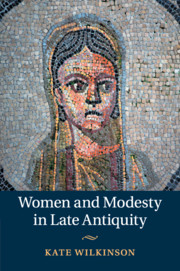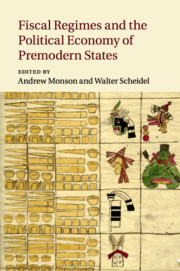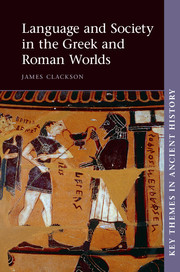Refine search
Actions for selected content:
23990 results in Ancient history
3 - Monarchy and the Education of the Roman People
-
- Book:
- Livy's Political Philosophy
- Published online:
- 05 March 2015
- Print publication:
- 18 May 2015, pp 36-54
-
- Chapter
- Export citation
13 - Problematic Masculinity: Antony and the Political Sphere in Rome
- from PART II - Sex and Status
-
-
- Book:
- Rome Season Two
- Published by:
- Edinburgh University Press
- Published online:
- 07 October 2017
- Print publication:
- 18 May 2015, pp 169-181
-
- Chapter
- Export citation
Contributors
-
- Book:
- Rome Season Two
- Published by:
- Edinburgh University Press
- Published online:
- 07 October 2017
- Print publication:
- 18 May 2015, pp x-xiv
-
- Chapter
- Export citation
8 - Revenge and Rivalry in Rome
- from PART II - Sex and Status
-
-
- Book:
- Rome Season Two
- Published by:
- Edinburgh University Press
- Published online:
- 07 October 2017
- Print publication:
- 18 May 2015, pp 105-116
-
- Chapter
- Export citation
4 - Tyranny and the Tyrannical Temperament
-
- Book:
- Livy's Political Philosophy
- Published online:
- 05 March 2015
- Print publication:
- 18 May 2015, pp 55-76
-
- Chapter
- Export citation
2 - Livy’s Preface: A Reader’s Guide to the First Pentad
-
- Book:
- Livy's Political Philosophy
- Published online:
- 05 March 2015
- Print publication:
- 18 May 2015, pp 22-35
-
- Chapter
- Export citation
Introduction: Livy and Domestic Politics
-
- Book:
- Livy's Political Philosophy
- Published online:
- 05 March 2015
- Print publication:
- 18 May 2015, pp 1-8
-
- Chapter
- Export citation
9 - Effigies of Atia and Servilia: Effacing the Female Body in Rome
- from PART II - Sex and Status
-
-
- Book:
- Rome Season Two
- Published by:
- Edinburgh University Press
- Published online:
- 07 October 2017
- Print publication:
- 18 May 2015, pp 117-127
-
- Chapter
- Export citation
Notes
-
- Book:
- Livy's Political Philosophy
- Published online:
- 05 March 2015
- Print publication:
- 18 May 2015, pp 141-180
-
- Chapter
- Export citation
Frontmatter
-
- Book:
- Rome Season Two
- Published by:
- Edinburgh University Press
- Published online:
- 07 October 2017
- Print publication:
- 18 May 2015, pp i-iv
-
- Chapter
- Export citation
Editor's Acknowledgments
-
- Book:
- Rome Season Two
- Published by:
- Edinburgh University Press
- Published online:
- 07 October 2017
- Print publication:
- 18 May 2015, pp ix-ix
-
- Chapter
- Export citation
4 - Class, Chaos, and Control in Rome
- from PART I - POWER AND POLITICS
-
-
- Book:
- Rome Season Two
- Published by:
- Edinburgh University Press
- Published online:
- 07 October 2017
- Print publication:
- 18 May 2015, pp 48-60
-
- Chapter
- Export citation

Women and Modesty in Late Antiquity
-
- Published online:
- 05 May 2015
- Print publication:
- 30 March 2015

Fiscal Regimes and the Political Economy of Premodern States
-
- Published online:
- 05 May 2015
- Print publication:
- 23 April 2015

Language and Society in the Greek and Roman Worlds
-
- Published online:
- 05 May 2015
- Print publication:
- 30 April 2015
Acknowledgements
-
- Book:
- Language and Society in the Greek and Roman Worlds
- Published online:
- 05 May 2015
- Print publication:
- 30 April 2015, pp xii-xii
-
- Chapter
- Export citation
5 - Language, gender, sexuality
-
- Book:
- Language and Society in the Greek and Roman Worlds
- Published online:
- 05 May 2015
- Print publication:
- 30 April 2015, pp 123-142
-
- Chapter
- Export citation
6 - The languages of Christianity
-
- Book:
- Language and Society in the Greek and Roman Worlds
- Published online:
- 05 May 2015
- Print publication:
- 30 April 2015, pp 143-170
-
- Chapter
- Export citation
4 - Language variation
-
- Book:
- Language and Society in the Greek and Roman Worlds
- Published online:
- 05 May 2015
- Print publication:
- 30 April 2015, pp 96-122
-
- Chapter
- Export citation
List of abbreviations
-
- Book:
- Language and Society in the Greek and Roman Worlds
- Published online:
- 05 May 2015
- Print publication:
- 30 April 2015, pp xiii-xiv
-
- Chapter
- Export citation
